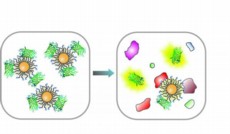Science
Newly demonstrated capabilities of low-powered nanotweezers may benefit cellular-level studies

Experimental setup schematic showing laser source, microscope, and imaging detector and spectrometer. The inset illustrates the two different sample configurations that were explored; red arrows correspond to the input polarization directions and black arrows depict the propagation vector.
- Read more
- 365 reads
Nanobotmodels presents new illustration of drug-delivery technology using nanodiamonds

Doxorubicin (Dox) is a drug used in cancer chemotherapy. It is an anthracycline antibiotic, closely related to the natural product daunomycin, and like all anthracyclines, it works by intercalating DNA, while most serious adverse effect being life-threatening heart damage.
- Read more
- 447 reads
Production of Manganite Nanocatalysts for Removal of Air-Polluting Volatile Organic Compounds

The nanocatalysts can be used in controlling the gaseous pollutants emitted from chemical and petrochemical industries and the exhaust of the automobiles.
- Read more
- 517 reads
First Planets Found Around Sun-Like Stars in a Cluster

Astronomers have discovered two gas giant planets orbiting stars in the Beehive cluster, a collection of about 1,000 tightly packed stars.
- Read more
- 483 reads
NASA Mars Rover Opportunity Reveals Geological Mystery

Small spherical objects fill the field in this mosaic combining four images from the Microscopic Imager on NASA's Mars Exploration Rover Opportunity. The view covers an area about 2.4 inches (6 centimeters) across, at an outcrop called "Kirkwood" in the Cape York segment of the western rim of Endeavour Crater. The individual spherules are up to about one-eighth inch (3 millimeters) in diameter.
- Read more
- 479 reads
New research suggests the Met Office has made steps forward in providing improved long-range guidance for winters.

Satellite Image of UK Snow
- Read more
- 437 reads
Nuclear Technologies Secure Food For Future
For nearly fifty years, applications of nuclear technology have been helping the world's farmers, contributing new varieties of crops, controlling pests, diagnosing livestock disease, improving soil and water management and increasing food safety.
- Read more
- 412 reads
Two Opposing Worlds Meet: Development or Death (Part I)
The Stockholm World Water Week, Aug. 26-31, sponsored by the Swedish state's International Development Cooperation Agency, and such global cartel companies such as Nestle and PepsiCo, but dominated by the World Wildlife Fund (WWF), the Stockholm Environmental Institute, and similar malthusian propaganda outlets, promised to be orgy in green ideological madness, where African and Asian nations are regarded by Europe and the U.S.A. as an embarrassing burden, and that those nations should be convinced that their misery could only be reduced, but not relieved, by small hand-outs, instead of large-scale industrial and infrastructural development.
- Read more
- 423 reads
UMass Amherst Chemists Develop Nose-like Sensor Array to 'Smell' Cancer Diagnoses

In a pre-clinical non-small-cell lung cancer metastasis model in mice developed by Frank Jirik and colleagues at the University of Calgary, Rotello's team at UMass Amherst use a sensor array system of gold nanoparticles and proteins to "smell" different cancer types in much the same way our noses identify and remember different odors.
- Read more
- 536 reads
A Celestial Witch’s Broom?

The Pencil Nebula is pictured in a new image from ESO’s La Silla Observatory in Chile. This peculiar cloud of glowing gas is part of a huge ring of wreckage left over after a supernova explosion that took place about 11 000 years ago.
- Read more
- 394 reads
Human Rights
Fostering a More Humane World: The 28th Eurasian Economic Summi

Conscience, Hope, and Action: Keys to Global Peace and Sustainability

Ringing FOWPAL’s Peace Bell for the World:Nobel Peace Prize Laureates’ Visions and Actions

Protecting the World’s Cultural Diversity for a Sustainable Future

Puppet Show I International Friendship Day 2020

